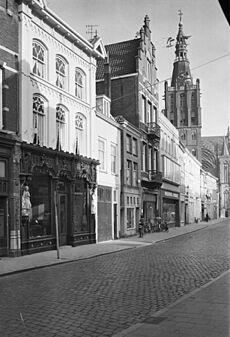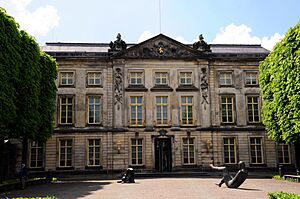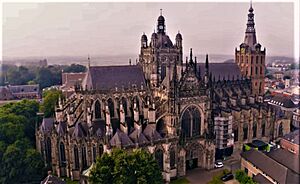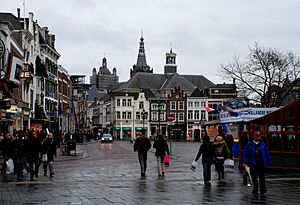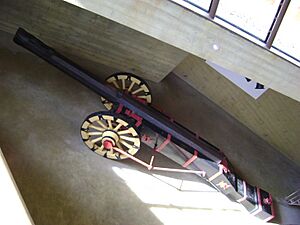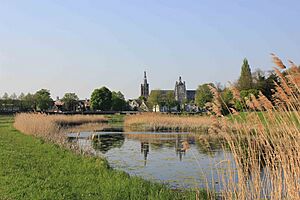's-Hertogenbosch facts for kids
Quick facts for kids
's-Hertogenbosch
Den Bosch
|
|||||
|---|---|---|---|---|---|
|
City and municipality
|
|||||
|
View over the city centre
The city seen from the Bossche Brook
Binnendieze canals
Dragon Fountain
North Brabant Museum
St. John's Cathedral
City hall of 's-Hertogenbosch
|
|||||
|
|||||
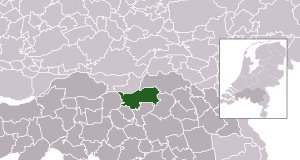
Location in North Brabant
|
|||||
| Country | Netherlands | ||||
| Province | North Brabant | ||||
| Government | |||||
| • Body | Municipal council | ||||
| Area | |||||
| • Municipality | 91.79 km2 (35.44 sq mi) | ||||
| • Land | 84.45 km2 (32.61 sq mi) | ||||
| • Water | 7.34 km2 (2.83 sq mi) | ||||
| Elevation | 6 m (20 ft) | ||||
| Population
(Municipality, May 2022; Urban and Metro, May 2014)
|
|||||
| • Municipality | 160,783 | ||||
| • Density | 1,704/km2 (4,410/sq mi) | ||||
| • Urban | 169,714 | ||||
| • Metro | 198,000 | ||||
| • Metro region | 355,230 | ||||
| • Brabant CMSA | 1,932,055 | ||||
| Demonym(s) | Bosschenaar | ||||
| Time zone | UTC+1 (CET) | ||||
| • Summer (DST) | UTC+2 (CEST) | ||||
| Postcode |
5200–5249
|
||||
| Area code | 073 | ||||
| Click on the map for a fullscreen view | |||||
s-Hertogenbosch, often called Den Bosch, is a city and municipality in the Netherlands. It has a population of about 160,783 people. This city is the capital of the North Brabant province. It is also the fourth largest city in the province. The city is located south of the Maas river and close to the Waal river.
Contents
History of 's-Hertogenbosch
The name 's-Hertogenbosch means "the duke's forest" in old Dutch. The duke was Henry I, Duke of Brabant. His family owned a large area nearby. He built a new town on some forested hills in the middle of a swamp.
Founding the City
In 1185, when he was 26, Duke Henry I gave 's-Hertogenbosch its city rights. This meant the city could trade and govern itself. The first official mention of the city is from 1196. The duke wanted the city to be a strong fortress. It would protect his land from nearby regions like Gelre and Holland.
In 1203, Gelre and Holland attacked and destroyed the city. But 's-Hertogenbosch was quickly rebuilt. You can still see some parts of the original city walls today.
Growth and Challenges
By the late 1300s, a much bigger wall was built around the city. This protected the growing area. People dug canals to create a moat using the Dommel and Aa rivers.
's-Hertogenbosch was the home of Hieronymus Bosch, a famous painter from the northern Renaissance period. The city was also a major music center. Many composers, like Jheronimus Clibano, learned music in its churches.
Until 1520, the city was very successful. It became the second largest city in what is now the Netherlands, after Utrecht.
Wars and Changes
The Reformation brought many changes. The city became its own bishopric (a church district). During the Eighty Years' War, 's-Hertogenbosch supported the Habsburg (Catholic) rulers. It stopped a Calvinist takeover.
The city was attacked many times by Prince Maurice of Orange. He wanted to bring 's-Hertogenbosch under the control of the Dutch Republic. The city successfully defended itself in 1601 and 1603.
However, in 1629, it finally fell during the siege led by Prince Maurice's brother, Frederick Henry.
The Swamp Dragon's Fall
Before the fighting started again in 1618, the city's defenses were made even stronger. The surrounding swamps made a normal attack almost impossible. The fortress was thought to be unbeatable, earning it the nickname moerasdraak, or "Swamp Dragon."
But in 1629, Frederik Hendrik of Orange used a clever Dutch trick. He changed the course of the Dommel and Aa rivers. He built a 40-kilometer (25-mile) dyke to create a dry area (a polder). Then, he used windmills to pump out the water. After a three-month siege, the city had to give up. This was a huge defeat for the Habsburgs during the Thirty Years' War.
After this, the city was cut off from the rest of its region. It was treated by the Dutch Republic as an occupied area, with fewer political freedoms.
From Louis XIV to Bonaparte
After the Peace of Westphalia, the city's defenses were improved again. In 1672, a difficult year for the Dutch, the city held strong against the army of Louis XIV of France.
In 1794, French revolutionary soldiers attacked the city. It was not well defended and fell quickly. This led to the end of the Dutch Republic.
Under the new Batavian Republic in 1795, all citizens finally gained equal rights. From 1806, the city was part of the Kingdom of Holland. In 1810, it became part of the First French Empire. The Prussians captured it in 1814.
Kingdom of the Netherlands
In 1815, when the United Kingdom of the Netherlands was formed, 's-Hertogenbosch became the capital of North Brabant. Many new and modern fortresses were built around the city. A new canal, the 'Zuid-Willemsvaart', was built. This helped the city's economy grow. Trade, manufacturing, and industry all increased.
Until 1878, it was not allowed to build outside the city walls. This caused overcrowding and a very high rate of infant deaths. At the end of the 1800s, the city government was very traditional. They stopped new factories from being built. They also prevented new schools, as they thought students would cause trouble. Because of this, the city's importance decreased.
World War II and Modern Times
During World War II, German forces occupied the city from 1940 to 1945. A Nazi concentration camp called Herzogenbusch (also known as 'Kamp Vught') was located nearby. About 30,000 people were held there, including 12,000 Jews.
The city was freed between October 24 and 27, 1944. This happened during Operation Pheasant by British soldiers.
After the war, 's-Hertogenbosch was modernized like many other Dutch cities. Luckily, its old town was saved from too much rebuilding. In 1956, the city council wanted to tear down the Moriaan, the oldest brick building in the Netherlands. They wanted to make more room for traffic. But the government refused, and the building was restored starting in 1963.
Today, city leaders care a lot about protecting historic buildings. The old fortifications are also being carefully preserved.
Geography and Climate
The municipality of 's-Hertogenbosch includes several smaller towns and villages. These include Bokhoven, Empel, Engelen, and Rosmalen.
Climate
The climate in 's-Hertogenbosch is mild. It has small differences between high and low temperatures. There is also enough rain throughout the year. This type of climate is called "Marine West Coast Climate."
Economy and Business
's-Hertogenbosch is an important center for industry, education, government, and culture. It is the fourth largest city in North Brabant. Many national and international companies have offices here. These include Heineken, Epic, Tyco International, and SAP.
The Jeroen Bosch Hospital is the biggest employer in the area. It has over 4,000 employees.
Culture and Events
's-Hertogenbosch hosts many exciting events. These include the Boulevard theatre festival and Jazz in Duketown. The city also hosted the start of the Tour de France in 1996. The International Vocal Competition and November Music festival also take place here.
The city is home to over 350 restaurants, pubs, and cafés.
Food and Language
The city has its own special food called the Bossche Bol. It's like a giant cream puff, bigger than a tennis ball. It's filled with whipped cream and covered in chocolate.
The local language is called Bosch. It is a type of Brabantian dialect and is very similar to regular Dutch.
Museums and Art
The Noordbrabants Museum shows works by Vincent van Gogh from his time in Brabant. The Design Museum Den Bosch focuses on modern art. The Jheronimus Bosch Art Center is dedicated to the famous painter Hieronymus Bosch.
Other museums include the Swan Brothers' House and Museum Slager. There is also the National (Dutch) Carnavalsmuseum. Soon, a new museum about the city's fortresses will open. You can also visit the house where Hieronymus Bosch painted his masterpieces.
Carnival Celebrations
's-Hertogenbosch has a strong carnival tradition. The story and symbols for this celebration started between 1881 and 1883. During carnival, the city is renamed "Oeteldonk" for three days. "Donk" means a dry place in a marsh. The frog is a common symbol during the 's-Hertogenbosch Carnival. It represents the Oeteldonk marsh.
Oeteldonk is seen as a village where everyone is a farmer or a durske (a girl). This removes class differences. The village is led by the Mayor "Peer vaan den Muggenheuvel tot den Bobberd." Each year, the real mayor of 's-Hertogenbosch hands over his power to the Mayor of Oeteldonk.
On Sunday at 11:11 AM, the Mayor of Oeteldonk welcomes Prince Carnaval "Prince Amadeiro XXVI" at the central station. A parade of carnival clubs then escorts them to the town hall.
People in 's-Hertogenbosch wear special traditional outfits during these days. They wear a boerenkiel (farmer's smock). Each year, new patches are designed based on the carnival's theme. These can be sewn onto the outfit. The boerenkiel is often worn with a farmer's bandana and a long scarf in the colors of Oeteldonk (red, white, and yellow). This tradition is different from other carnival celebrations in the Netherlands.
Main Attractions
's-Hertogenbosch was built as a fortified city. You can still see this history today. After World War II, there were plans to modernize the old city. This included filling in canals and changing old walls. However, the government declared the city a protected area. Most historic parts have been saved.
Unlike cities like Rotterdam, 's-Hertogenbosch was not badly damaged during Second World War. Much of its history remains. Today, many old buildings, walls, churches, and statues are being restored for future generations.
The City Center
The city center feels cozy because of the old walls that still surround it. The many rivers that meet in 's-Hertogenbosch shaped its unique street plan. This is different from cities with straight, grid-like streets.
The most important building in the center is Saint John's Cathedral. It was built around 1220. It is famous for its Brabantine Gothic style. You can see many sculptures of craftsmen sitting on its arches and edges. A big restoration was finished in 2010.
On the main square is 'de Moriaan'. This is the oldest brick house still standing in the Netherlands. It was built in the early 1200s. In the 1960s, it was restored to look like it did in a famous 16th-century painting. The town hall is an original 14th-century Gothic building. After the Dutch Republic took over in 1629, it got a new front in the Dutch Baroque architecture style.
Hidden beneath the old city is a network of canals called the Binnendieze. It used to be 22 kilometers (14 miles) long. It started as the Dommel river flowing through the city. People built houses and roads over the river because of limited space. Later, the Binnendieze became a sewer and fell apart. In recent years, the remaining parts of this old waterway have been restored. You can now take guided boat trips through them.
The Fortifications
's-Hertogenbosch has a very large and almost complete city defense system from the 1400s to 1600s. It used the city's strong natural position on a sandy hill in a large swamp. This also helped preserve the main walls, as they were vital for keeping out water. In 2004, the city was named "European Fortress City of the year." Since then, many of its defenses have been restored.
Besides small parts of medieval walls, the main defense is a late-medieval wall from the 1400s. Parts of the top were removed when cannons became stronger. New, angled bastions were added later. The citadel in the northwest still has its original height. Many other fortresses can be seen around the city.
In the northeast of the old city, there is a hexagonal gunpowder magazine called Kruithuis. It is one of the few left in the Netherlands. It was built when the city was part of the Spanish Netherlands. It is planned to become a museum about the fortresses of 's-Hertogenbosch. One of the bastions now holds a small museum called Bastionder. It was dug out inside a bastion on the south side. Inside, you can see a unique iron cannon and an older bastion that was covered by the current one.
Nature Areas
South of the city, the center and walls border the Bossche Broek. This is an old polder (a low-lying area of land) that could never be fully dried. In 1995, a dike broke, and a lot of water flooded the polder. It also blocked the main Dutch highway. To prevent this, the area was changed to hold extra water in emergencies. By 2006, it had higher dikes and locks. These allow controlled flooding of the polder and nearby areas if needed.
The Bossche Broek is now a 22-hectare nature reserve. It reaches all the way to Vught. It connects to other nature areas, forming a Natura 2000 site. Rare animals like the scarce large blue butterfly and the European weather loach fish live here. The Moerputten area has the Moerputten Bridge. This is a 600-meter (650-yard) long railway bridge from the 1800s. What makes this area truly special is how close it is to the city center.
Unique Buildings
The city is also home to the Bolwoningen complex. These are fifty experimental round houses designed by Dries Kreijkamp.
The Lutheran Church, 's-Hertogenbosch is no longer used for church services.
Sports in 's-Hertogenbosch
The city has one professional football club, FC Den Bosch. It was formed in 1967. As a successor to an older club, BVV, FC Den Bosch can claim the national championship from 1948. This win led to the building of the De Vliert stadium. It used to hold 30,000 people, but now it holds 8,500. Ruud van Nistelrooy, a famous Dutch international player, started his career at FC Den Bosch.
's-Hertogenbosch is more successful in field hockey. It has a top club called HC Den Bosch. The women's team is especially strong in the Dutch field hockey league. The professional basketball club New Heroes Den Bosch is also very successful.
The city's rugby club is called The Dukes. It started in 1974. It is located at the foot of the city walls. Because of limited space, the club plays on artificial turf. Part of its building is underground. The Dukes has the most young members and became the national rugby champion in 2008.
The city hosts the Rosmalen Grass Court Championships. This is a tennis event for both men and women. It is played two weeks before the Wimbledon Championships. The World Archery Championships were held here in June 2019. The finals took place at the Parade, a historic square near Saint John's Cathedral.
Transportation
The Zuid-Willemsvaart canal runs from the Meuse river through the city. Because of its route, it could not be made wide enough for larger ships. So, the Máxima Canal, 8 kilometers (5 miles) long, was dug east of the city. This new canal provides a shortcut to the Meuse for bigger ships. The remaining part of the Zuid-Willemsvaart west of the city is used as an industrial harbor. There is also a marina in the city center.
's-Hertogenbosch is on the busy A2 motorway. This is the most important north-south road in the Netherlands. The city is also on the A59 motorway for east-west travel.
's-Hertogenbosch railway station is on a main railway line between Amsterdam and the industrial center near Eindhoven. Trains run every ten minutes on this route. Other stations in the municipality are 's-Hertogenbosch Oost railway station and Rosmalen railway station.
The city has worked to become more bicycle-friendly. Many bike paths have been built. In 2011, 's-Hertogenbosch was named Fietsstad 2011 (Bicycle City 2011). This award was given to encourage the city to do even more for cycling.
Education
's-Hertogenbosch has several vocational universities. The HAS Hogeschool has about 3,500 students. It focuses on farming and food technology. Avans Hogeschool also has a campus here. The AKV St. Joost is an art academy that is part of Avans. It dates back to 1812.
The Jheronimus Academy of Data Science (JADS) is located in the city center. It offers programs in data science for graduate and post-graduate students. It is a part of the Eindhoven University of Technology and Tilburg University.
For secondary education, the City Gymnasium is a school that came from the city's old Latin school. It is similar to a grammar school and has been around since 1274. Other large schools offer all types of secondary education.
Religion
Religions in 's-Hertogenbosch (2013) No affiliation (44.8%) Roman Catholic (43.3%) Protestant (4.1%) Other Christian denominations (2.1%) Islam (5%) Hinduism (0.3%) Buddhism (0.4%)
Roman Catholicism is the main religion in 's-Hertogenbosch. Over 40% of the people identify as Catholic. Three Catholic churches in the city center are still used: Saint John's Cathedral, Saint Catherine, and the Monastery Church of the Franciscans.
The number of Protestant believers has decreased to about 4%. Their main church is the Great Church. The Eastern Orthodox Church is new in town. It uses Saint Catherine's Church.
The Moroccan community built the Arrahma Mosque. The Turkish community has the Orhan Gazi Mosque.
Famous People from 's-Hertogenbosch
Many notable people have come from 's-Hertogenbosch.
Public Service and Thinkers
- Erasmus (1484–1497), a priest and scholar.
- Macropedius (1487–1558), a humanist, schoolmaster, and Latin playwright.
- Jan de Quay (1901–1985), a politician and psychologist who was Prime Minister of the Netherlands.
- Bram Stemerdink (born 1936), a retired politician and army officer.
- Marco Kroon (born 1970), a soldier.
Science and Business
- Gerardus Mercator (ca.1520–1530), a famous geographer and mapmaker.
- Willem 's Gravesande (1688–1742), a mathematician and philosopher who studied the laws of physics.
- Frans de Waal (born 1948), a primatologist who studies animal behavior.
Arts and Culture
- Hieronymus Bosch (ca.1450–1516), a world-renowned painter.
- Abraham van Diepenbeeck (1596–1675), a Dutch painter.
- Leon de Winter (born 1954), a well-known writer and columnist.
- Oscar van Dillen (born 1958), a composer and conductor.
Sports Stars
- Henri Smulders (1863–1933), a sailor who won a silver medal at the 1900 Olympics.
- Mijntje Donners (born 1974), a field hockey player who won silver and bronze medals at the Olympics.
- Marianne Vos (born 1987), a Dutch bicycle racer who competes in many cycling sports.
- Patrick van Aanholt (born 1990), a professional football player.
- Maartje Goderie (born 1984), a field hockey player who won two Olympic gold medals.
| Historical population | ||
|---|---|---|
| Year | Pop. | ±% p.a. |
| 1374 | 14,526 | — |
| 1438 | 12,973 | −0.18% |
| 1464 | 10,507 | −0.81% |
| 1473 | 10,579 | +0.08% |
| 1480 | 13,185 | +3.20% |
| 1496 | 15,552 | +1.04% |
| 1526 | 18,571 | +0.59% |
| 1560 | 17,500 | −0.17% |
| 1600 | 18,000 | +0.07% |
| 1665 | 9,000 | −1.06% |
| 1747 | 12,574 | +0.41% |
| 1795 | 12,841 | +0.04% |
Images for kids
See also
 In Spanish: Bolduque para niños
In Spanish: Bolduque para niños
















